The heater's inbuilt pump system makes sure the unit is able to avoid temperature variations, ensuring its high-efficiency operation. The self-limiting PTC heating element all but guarantees that this tiny appliance won't be able to overheat.
The adjustment knob is inconvenient.
Hydor T08203 is a high-precision, effective, and efficient aquarium heater. The compact unit is easy to install and easy to use. It will be able to accommodate tanks with 5/8" inside diameter tubing. You can also purchase 200-watt models.
In-Line External Heater
Marine and tropical aquariums
~ 75 - 100 gallons
300 W
65 - 93°F
Self-limiting PTC heating element
1 year
The instructions are lacking.
Hygger Submersible Pinpoint Aquarium Heater is rugged, durable, and accurate. You can submerge this unit into most tanks without worrying about its circuits. You'll be able to make sure the fish inside the tank are happy and comfortable.
Submersible Heater
Freshwater, saltwater aquariums, and reef tanks
10 - 25 gallons
100 W
32 - 104°F
IPX8 waterproof level, Completely shatterproof, Corrosion-resistant, Auto shut-off
1 year
The heater is pretty slow.
Fluval A774 is smart. Its advanced processor uses dual temperature sensors to secure accurate real-time temperature readings. Though the unit's profile is quite slim, you won't have to worry about its safety. The heater will be able to support 100-gallon tanks.
Submersible Heater
Freshwater and saltwater aquariums
Up to 100 gallons
300 W
68 - 93°F
Protective casing, safety shut-off
5 years
Might not cut it for 60-gallon tanks.
In addition to freshwater and saltwater aquariums, VIVOSUN Aquarium Heater can be put inside and used with most glass containers, hydroponic systems, and aquacultures. All the necessary certifications are there. The unit is pretty much indestructible yet sophisticated.
Submersible Heater
Freshwater and saltwater aquariums, aquaculture, glass containers, and hydroponic systems
50 - 60 gallons
300 W
68 - 94°F
IP68 waterproof level, Explosion-proof and anti-corrosion protection, Overheat and water shortage protection, CE, FCC and ROHS certification, The plug has a UL certification
1 year
The shatter-resistant quartz glass will have no issues withstanding aggression from different fish species/invertebrates. The automatic shut-off feature will make sure the unit never overheats. The red LED light will tell you when the heater is working.
The suction cups won't always last.
Aqueon 100106251 Preset Heater will be able to make most tropical fish species comfortable. You won't have to regulate the temperature. You won't have to tinker with the settings. This basic unit will get the job done without major effort and money investments on your part.
Submersible Heater
Freshwater and saltwater aquariums
2 - 10 gallons
50 W
Constant 78°F
Shatterproof construction, Auto shut-off
1 year
This site is a free online resource that strives to offer helpful content and comparison features to its visitors. Please be advised that the operator of this site accepts advertising compensation from certain companies that appear on the site, and such compensation impacts the location and order in which the companies (and/or their products) are presented, and in some cases may also impact the scoring that is assigned to them. The scoring that appears on this site is determined by the site operator in its sole discretion, and should NOT be relied upon for accuracy purposes. In fact, Company/product listings on this page DO NOT imply endorsement by the site operator. Except as expressly set forth in our Terms of Use, all representations and warranties regarding the information presented on this page are disclaimed. The information which appears on this site is subject to change at any time. More info
Hydor T08203
Self-Limiting PTC Element
Hydor T08203 looks somewhat unassuming. Sure, the housing is pretty sleek. The black finish is glossy but, at the same time, subtle and even relatively understated.
The entire unit measures 4 x 4 x 12.5 inches, which is pretty standard as far as these aquarium heaters are concerned. Its weight barely reaches one pound, so you'll be comfortable handling and placing this thing.
When you don't necessarily care about these heaters' aesthetics (which is understandable), this compact unit looks basically like every other aquarium heater you've seen before. That's not even remotely the case though. There's pretty much only one difference between this model and most of these heaters but that one difference is huge.
As far as we're aware, what we have here is the first aquarium heating appliance that comes equipped with the company's exclusive PTC tech. Using this PTC heating element, the system is able to self-limit, pretty much guaranteeing complete safety against overheating. All you have to make sure is that the ETH model is used in a vertical fashion to ensure correct operation.
Generally speaking, the technologies that are similar to this PTC tech are designed to be put onto return lines coming from various canister filters. That being said, this particular unit is easily adaptable and can be installed pretty much anywhere where heated aquarium water is a requirement (like with wet/dry sump pumps).
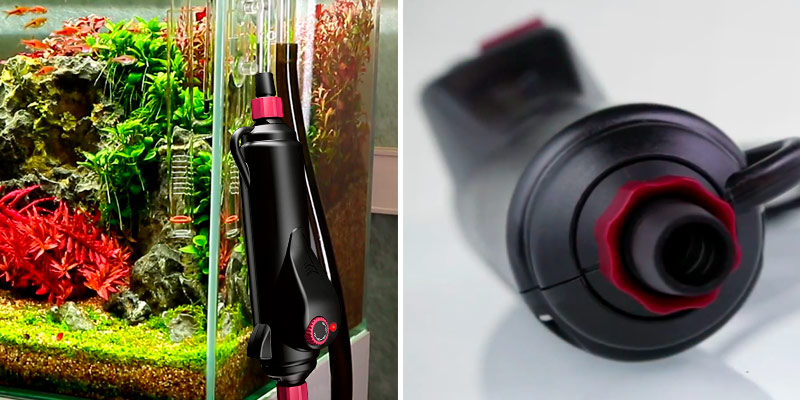
Avoids Temperature Variations
Using an internal heat pump system, the unit is able to avoid temperature variations, allowing this thing to heat with high efficiency.
Generally speaking, the people behind this product have designed it to be used with freshwater and marine aquariums. You should have no issues with most canister filters, including but not limited to Hydor Prime, Rena Filstar, Eheim canisters, and Fluval canisters as long as you use the tubing's short section to complete the connection.
Despite its compact size, Hydor T08203 will be able to accommodate ~ 75 - 100-gallon tanks. You'll be able to regulate the temperature between 65 and 93 degrees Fahrenheit. The product's biggest flaw has to do with that though. Not necessarily something to cry about but the adjustment knob that regulates the temperature is pretty inconvenient.
On the bright side, drawing 300 watts, this unit will be able to quickly turn the temperature inside the tank from cold to lukewarm to pleasant.
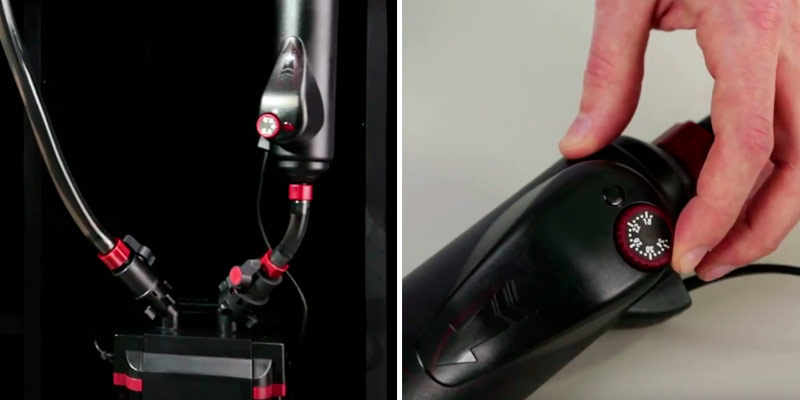
Additional Info
| Last updated price | $73.60 |
| Stock | In stock |
| ASIN | B0002Z7VQE |
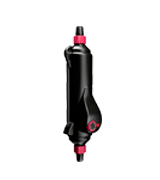
Hygger Saltwater Tank Titanium
Choose Any Temperature
Hygger Submersible Pinpoint Aquarium Heater will make sure you have no issues keeping the tank at the right temperatures. Before anything else though, the product is available from 50 watts to 500 watts, so you'll definitely be able to find the one that fits your aquarium. We'll be reviewing the 100-watt model but, aside from how much power the unit draws and uses, there are no differences between these models, meaning that what we're writing here will be relevant towards them all.
First, the product looks somewhat clunky and awkward but that's not something that we usually hold against aquarium heaters. More often than not, nobody cares how these heaters look, although we can appreciate it when some thought has been put into the unit's aesthetics.
Before anything else, this appliance is tough. Its IPX8 rating means that you can submerge the unit without worrying about its circuitry. The two suction cups that come supplied with the package will let you comfortably mount this thing onto most tanks. All you have to do is make sure the unit is placed where the water flow is considerable, that's how you'll be able to secure the same temperature throughout the entire aquarium.
The heater comes equipped with this separate controller that will let you easily and comfortably adjust the temperature from low to high without even taking out the unit from the tank. You'll be able to regulate the temperature anywhere between 32 and 104 degrees Fahrenheit, meaning that this model will prove suitable for most aquariums that house most fishes.
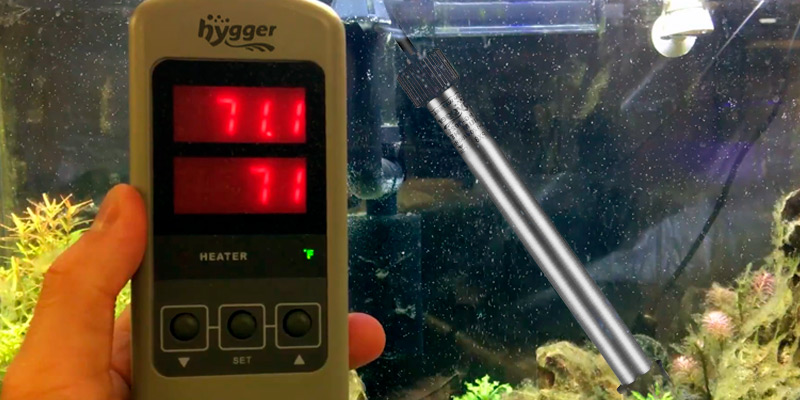
Titanium Housing
But we've somewhat digressed here. Again, the unit is tough. Aside from the aforementioned waterproof housing, this titanium heater is completely shatterproof because there's no glass in its construction. All we have here is heavy-duty, sturdy titanium and plastic tubing. Since titanium is up there with the most corrosion-resistant metals, the heater is more than compatible with saltwater aquariums and reef tanks.
Apart from that, the unit's pretty straightforward and intuitive. The large LCD screen is easy to read. It is divided into two sections, with the upper section displaying water temperature and the lower section reserved for the set temperature. You'll be able to choose between Celcius and Fahrenheit systems. The unit will let you control the temperature in 1-degree Fahrenheit and 0.5-degree Celcius increments.
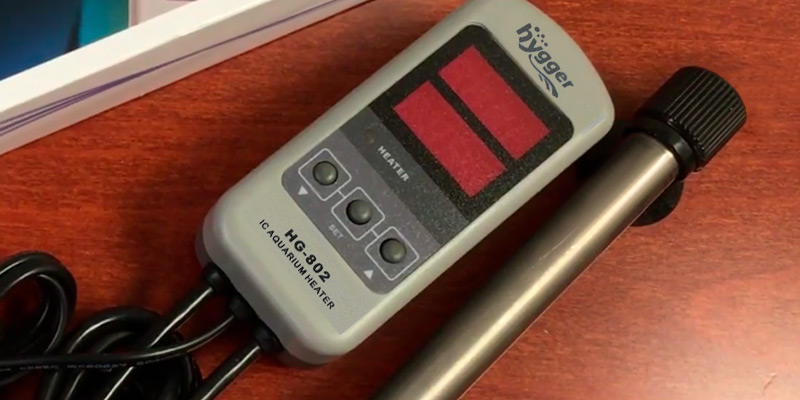
Additional Info
| Last updated price | $57.99 |
| Stock | In stock |
| ASIN | B07HGV7VRW |
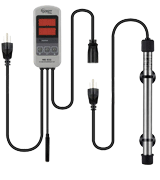
Fluval A774
Fish Guards
Fluval A774 appears pretty basic. The unit is anything but though. The streamlined construction and the trim but somewhat uninspired build make this little appliance look quite bland. Surprisingly enough, this "bland" notion is divorced from reality. There's pretty much nothing bland about this heater.
First and foremost, the company's VueTech tech ensures precision and secures safety. During normal operation, the temperature readouts will change color when the water inside the tank varies +/-2 degrees Fahrenheit or more from the temperature that you have pre-set.
Should any external heat sources (like chillers, for example) cause the temperature inside the tank to fall or rise more than 5.5 degrees Fahrenheit, the unit's screen will flash to indicate potential risks. You can also change the values to Celcius.
That's not everything that Fluval A774 is packing on the safety front though, not even remotely. Equipped with integrated fish guards, the unit is as tough as they get. Its protective casing will make sure that fish and various invertebrates are unable to come into direct contact with the unit's core. At the same time, the glass sleeve is pretty tough too, protected from shocks that large fish species are usually able to cause.
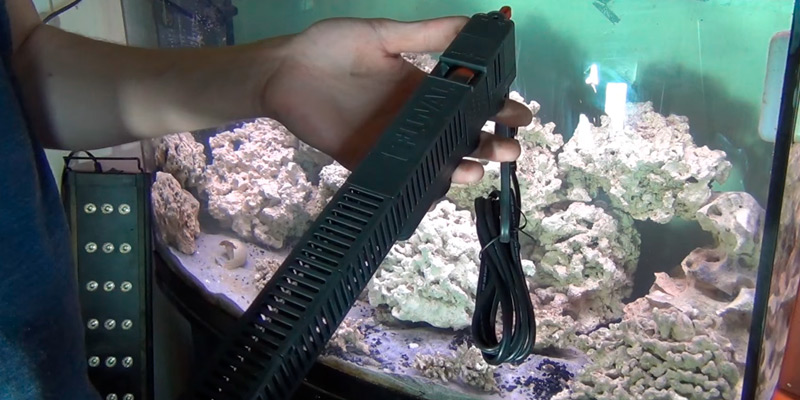
Choose the Angle
Of course, the product has its flaws. As far as we're concerned though, these flaws are basically limited to the fact that this unit takes its sweet time to heat up the water inside the tank. That's somewhat unfortunate considering that the appliance draws 300 watts, so the low heating speed makes very little sense.
On the upside, the heater's slim and secure profile comes fitted with versatile mounting brackets. You can adjust and even remove the unit without removing these brackets. Also, the bracket lets you mount the unit at different angles, letting you position the screen so that you're able to view the readouts from any direction you want.
The heater will let you regulate the temperature anywhere from 68 and 93 degrees Fahrenheit, which is pretty standard as far as aquarium heaters are concerned. This nice little lever will enable you to easily set the temperature in 0.5° increments, so you'll be able to make the fish as comfortable as possible.
When everything else fails, the unit also comes equipped with this safety shut-off mechanism that will prevent overheating no matter what.
In other words, though not even remotely expensive, Fluval A774 will do and let you do everything that high-end tank heaters can do.

Additional Info
| Last updated price | $0.00 |
| Stock | In stock |
| ASIN | B001VMSK0I |
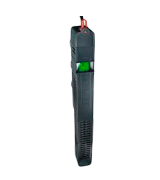
VIVOSUN Aquarium Heater
All the Protection Mechanisms
VIVOSUN Aquarium Heater is hands-down the sleekest, most modern-looking unit on this list. Its slim profile measures 15.5 x 3.3 x 1.7 inches, meaning that the heater will barely be taking away any space at all.
The smooth finish adds to the unit's aesthetic, which is nice even though these heaters can look however they want and still attract customers because these things are not about aesthetics first.
Of course, these tank heaters ought to be safe, comfortable, and reliable before anything else but the people behind this product have been able to check these demands off too.
From the safety standpoint, the unit's IP68 protection rating means you can submerge this compact appliance as deep as you want without worrying about its components.
In addition to that, the titanium tube will be able to last no matter what. It is explosion-proof, so you won't have to worry about sudden and extreme temperature changes causing anything. The tube's also corrosion-resistant, meaning you can put this thing inside saltwater aquariums (also aquaculture, most glass containers, and hydroponic systems but that's beside the point).
The anti-flaming casing will be preventing fish from getting too close to the unit, so you won't have to take various aquatic creatures' safety into account too. At the same time, the overheat and water shortage protection mechanisms will be able to prevent any accidents.

Intelligent Lights
Utilizing an intelligent IC chip, the heater allows you to control the temperature, making changes within ±1°C/±2ºF. That's not necessarily impressive since there are heaters that let you regulate within ±0.5℃/±1°F but, truth be told, these increments are excessive and unnecessary more often than not. You'll be able to regulate the temperature within a 68 - 94°F range.
Now that we've covered safe and reliable, what makes the unit comfortable is two things - its build and an external temperature controller. Using the latter, you'll be able to change the temperature inside the tank, all while making sure your hands don't get wet. The touch-button remote is easy to use. When you press the "set" button, the screen will flash to indicate that you can regulate the water temperature now.
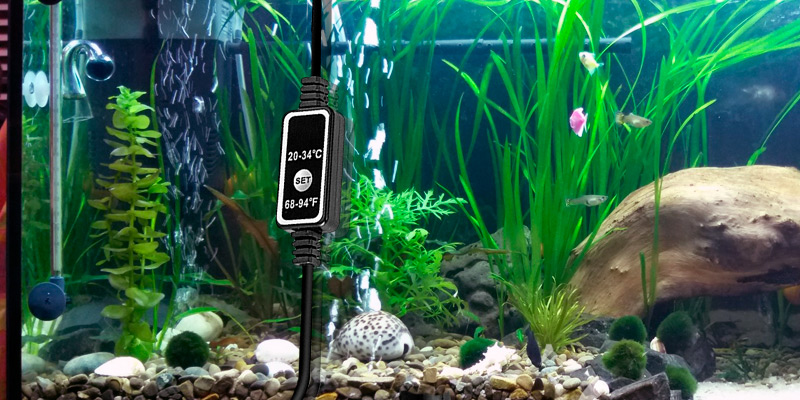
Additional Info
| Last updated price | $26.99 |
| Stock | May be out of stock |
| ASIN | B07TXN9VST |
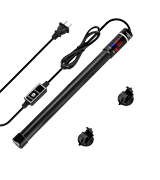
Aqueon 100106251
Basically Free
Aqueon 100106251 Preset Heater is fairly interesting but somewhat weird too. Though the unit looks the part, the heater is not as sophisticated as the units we've reviewed above. In fact, you could call this heater pretty basic.
Of course, the price reflects that. Since the product costs less than 10 bucks whereas most aquarium heaters cost somewhere between 35-70 bucks, you cannot measure this unit's value using the same standards.
Generally speaking, we've no major qualms with this product except that the supplied suction cups lose their adhesive properties pretty quickly, so you'll probably have to replace them in a few years. That's a shame since, otherwise, these cups are quite nice and let you place them vertically or horizontally within the tank. Apart from that though, there's not much here to complain about.
First off, the unit is tiny. Measuring 3.5 x 1.5 x 7 inches, you won't have to worry about this heater taking away that precious aquarium space from aquatic creatures. Also, the unit weighs 7 ounces, so you'll be able to comfortably pick up and move this thing when necessary.
You won't have to do that often though since the heater comes pre-calibrated at 78 degrees Fahrenheit. In other words, you won't be able to regulate the temperature.
On paper, that's kind of a bummer since you'd probably want that option but, generally speaking, that's appropriate and more than comfortable for most tropical fish species, meaning that the absolute majority of customers will have no issues with the pre-calibrated temperature.

Shatter-Resistant Quartz Glass
Power-wise, the appliance will be drawing and outputting no more than 50 watts, so you won't be adding anything to the energy bills. Of course, you won't be able to use this unit to maintain comfortable temperatures within large aquariums too, that goes without saying. You'll be able to make most tanks that measure somewhere between 5 and 10 gallons work though.
Though more than affordable, this aquarium heater is as rugged and durable as they come. Housing shatter-resistant quartz glass, the unit will be able to survive most encounters with ease.
Apart from that, the automatic shut-off feature will work wonders preventing overheating, so you won't have to worry about safety. There's also this red LED light that will indicate that the appliance is operating, meaning you'll be able to tell when the unit stops working.
To sum up, considering the price tag, Aqueon 100106251 Preset Heater is as good as these heaters get.
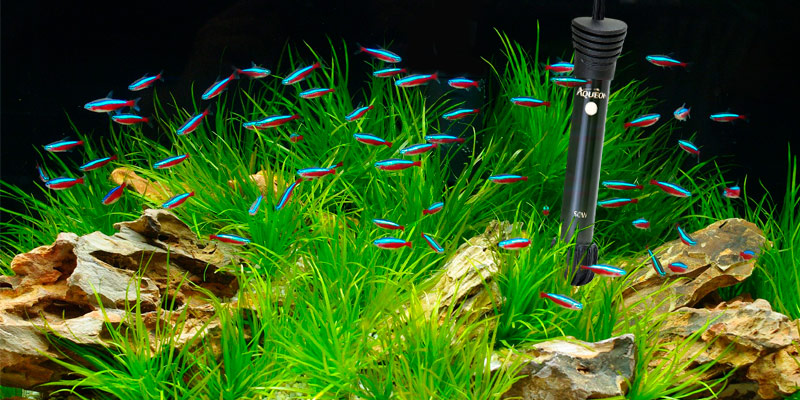
Additional Info
| Last updated price | $0.00 |
| Stock | In stock |
| ASIN | B00Q78MMT6 |
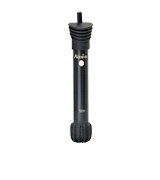
What Is an Aquarium Heater?
Aquariums are underrated. Seriously, they are. There are many reasons to keep fish, including various health benefits. Watching these majestic aquatic creatures swim there helps you relax and maintaining the tanks where these creatures live gives you purpose and reason to get out of bed in the morning.
Before anything else though, these aquariums require aquarium heaters. More often than not, tropical fish cannot survive without these water heaters keeping the temperature nice and warm. Fortunately, these heaters are not that difficult to choose, and we've broken down these difficulties in the What Features to Compare section, so you should have no issues figuring out the right unit.
Apart from everything we've described in that section, we would also recommend making sure that the unit's size won't be able to obstruct the view, so look into models with slim profiles and the ones you can position vertically first and foremost.
What Features to Compare
Type
First, you have to figure out the heater's type. Generally speaking, these heaters are categorized into in-line external heaters and submersible heaters. As you'd imagine, the differences between these units are obvious and straightforward.
The only thing we'd like to mention is that, when you choose submersible heaters, make sure that the unit comes with an external controller so that you're able to change the temperature without taking out the heater and/or getting your hands wet. Apart from that, most small tanks and large tanks have no issues with both heater types.
Compatibility
This one can be important, even though most models are compatible with most aquariums. Generally speaking, aquarium heaters are able to support most freshwater tanks, saltwater aquariums, reef tanks, and sometimes, even different glass containers and hydroponic systems.
Volume Range
This is where you have to pay extra attention. These heaters go from 1-2 to 100+ gallons, meaning that some might not even be enough to support most small aquariums, while other models will have no issues with large tanks. Make sure that the heater you're looking to purchase will be able to accommodate your aquarium's volume.
Power
Needless to say, these heaters are not mechanical devices, meaning that they're drawing and outputting watts. Generally speaking, the unit's output will tell you how quickly it will be able to heat up the entire aquarium and how large these aquariums can be but these numbers can be misleading, so we would not recommend relying on them to tell the whole story.
Temperature Regulation
Mid-range and high-end aquarium heaters will let you regulate the water temperature inside the tank. Sometimes, you'll be able to do that via separate controllers. Sometimes, you'll have to dunk your hand inside the tank to access these settings.
More often than not, these heaters let you adjust the temperature somewhere within the 65 - 95 degrees Fahrenheit range.
Occasionally though, you'll be able to change the temperature somewhere from 30 to 100 degrees but these heaters are rare.
Budget models come with pre-set temperatures somewhere around 78 degrees and you cannot change that.
Protection
Most aquarium heaters come equipped with an automatic shut-off feature that makes sure these units do not overheat. Sometimes, there are also various anti-corrosion solutions and shatterproof casing to prevent any accidents and extend the unit's lifespan.
Saltwater versus Freshwater Aquariums
There are many myths surrounding freshwater and saltwater aquariums. We've no idea why though. Most freshwater aquarists know nothing about saltwater aquariums and operate/think based upon various myths that are usually inaccurate, to say the least. We're here to debunk these myths. So, without further ado, let's get right into it.
Freshwater Aquariums are Easy to Keep Compared to Saltwater Ones?
Not really but, as far as these myths go, this one is not completely misguided. This idea comes from the fact that the water conditions (pH, salinity, chloride, and more) in the oceans do not change that much at all. In other words, saltwater fish species day-to-day living conditions remain pretty constant.
Freshwater environments, on the other hand, experience noticeable cyclical changes, including but not limited to flooding and drying. These constant changes impact the waters' chemical composition and temperature. In other words, freshwater environments tend to be dynamic and inconsistent.
Because that's the case, freshwater fish species have evolved to adapt to various water conditions, whereas saltwater fishes are not as used to these changes, so even the smallest water chemistry variations can cause huge issues with them. Since you don't have to manage the conditions within this tight threshold, most people find freshwater fish species and aquariums easier to keep and maintain.
You Cannot Turn Saltwater Aquariums Into Freshwater Aquariums?
False. This time, not even remotely accurate. You can absolutely convert freshwater tanks into saltwater tanks and vice versa. Furthermore, the process is way less complicated and challenging than you'd think.
Repurposing freshwater tanks into saltwater aquariums is especially easy. All you have to do is drain the tank, rinse everything, and wipe the whole thing clean. The water you're using to rinse the aquarium ought to be warm and chlorine-free. You'll have to replace the substrate and the filters but that's about it. Of course, with saltwater tanks, you'll also need to purchase a powerhead and a protein skimmer.
Converting saltwater tanks into freshwater ones is more difficult but nothing too challenging. Basically, you have to complete the same procedure we've described above except that you'll have to be much more thorough and make sure that there are no traces of salt left on the bottom, walls, and accessories.
You'll Have No Issues Breeding Both Fish Types in Captivity
That'd great but, unfortunately, that's not the case. More often than not, even complete beginners will be able to breed freshwater fish.
Saltwater fish species are different though. These species choose to breed throughout seasonal changes. As you'd imagine, captivity means that seasonal changes are non-existent within the aquarium because they're practically impossible to recreate artificially.
Since saltwater fish species that live inside aquariums do not receive any seasonal signs persuading them to mate, expecting them to breed would not be much more than a fool's errand. That's also why saltwater fishes usually cost more than freshwater ones.


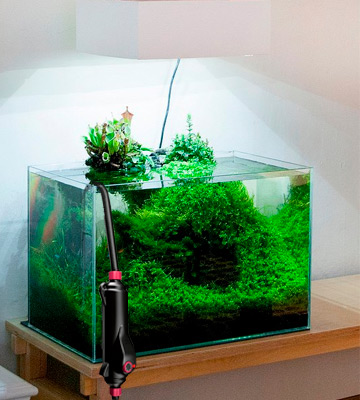
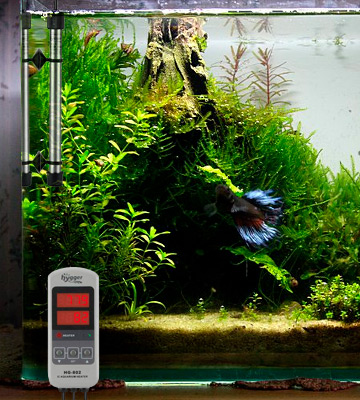
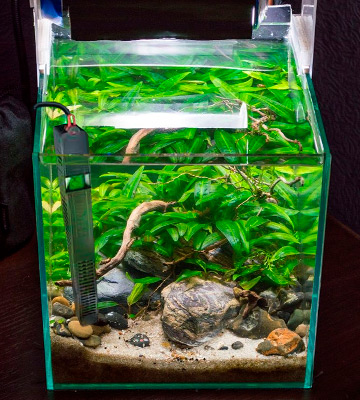
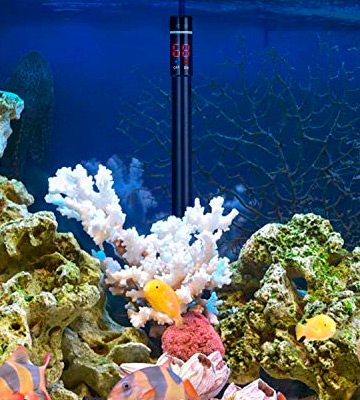


Your comment was successfully sent
Error! Please try again later